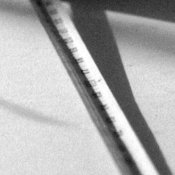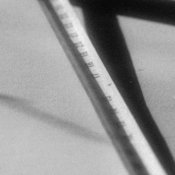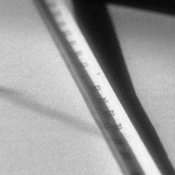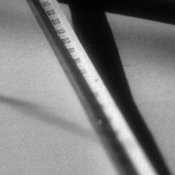ntenny
Subscriber
I recently scored myself a Bay I "Rollei-Infrarot" filter. These are Rollei's own infrared filters for their TLRs, and are widely understood to include not just filtration but also a weak lens that compensates for the IR focus shift. However, there is a lot of uncertainty about whether they always have optical compensation or only certain versions, whether the compensation is appropriate for modern near-infrared films or specific to the old HIE, and so on, so I thought I'd do some semi-controlled tests with my Rolleicord and a roll of Efke IR820.
The filter seems to be similar to an R72 or 89B. It looks opaque to a casual glance, but if you hold it up to your eye you can see a dim red image through it, and the images I got seem basically like those I've taken in the past with an R72. I don't know how to determine the age of the filter; there's no visible serial number. The rim says "Franke & Heidecke - Germany - Rollei-Infrarot - 28,5ø" (that's a lower case phi at the end)".
I set up a measuring tape and took four exposures, one unfiltered and three with the filter on: (1) at the same point of focus, (2) focused about three inches closer, (3) focused about three inches further. I don't remember what the exposures were, but I metered at EI 100 with no filter and EI 6 with the filter and the density of the negatives suggests that this was about right. (I had evening sun, which is relatively high in IR relative to visible wavelengths.) The results are attached; these are actual-pixel crops from negative scans. They aren't an ideal reference for critical comparisons, but all we need to do here is recognize the point of focus in each image.
The unfiltered exposure shows that I missed my focus slightly; I was aiming for the red 16 mark but ended up closer to the 17. I blame my eye and the dim screen rather than camera adjustment.
Image 2, with no change in focus, is basically identically focused, suggesting that the optical compensation is there and correct. Similarly, image 3, where I focused visually at about 13, is focused on the 13, and image 4 is around 20 or 21 rather than the 19 I was aiming for (probably just meaning I missed again).
Conclusions: (1) Rolleicords are kind of hard to focus, (2) my eyes are old, and (3) no focus compensation is required with this filter when using the Efke film.
It's possible that even with an uncompensated filter I wouldn't need to make an adjustment with this near-IR film. To be fair, I should run the same test with a conventional IR filter, but I got distracted and took some pictures of plants instead. They weren't very good but they were focused correctly.
-NT
The filter seems to be similar to an R72 or 89B. It looks opaque to a casual glance, but if you hold it up to your eye you can see a dim red image through it, and the images I got seem basically like those I've taken in the past with an R72. I don't know how to determine the age of the filter; there's no visible serial number. The rim says "Franke & Heidecke - Germany - Rollei-Infrarot - 28,5ø" (that's a lower case phi at the end)".
I set up a measuring tape and took four exposures, one unfiltered and three with the filter on: (1) at the same point of focus, (2) focused about three inches closer, (3) focused about three inches further. I don't remember what the exposures were, but I metered at EI 100 with no filter and EI 6 with the filter and the density of the negatives suggests that this was about right. (I had evening sun, which is relatively high in IR relative to visible wavelengths.) The results are attached; these are actual-pixel crops from negative scans. They aren't an ideal reference for critical comparisons, but all we need to do here is recognize the point of focus in each image.
The unfiltered exposure shows that I missed my focus slightly; I was aiming for the red 16 mark but ended up closer to the 17. I blame my eye and the dim screen rather than camera adjustment.
Image 2, with no change in focus, is basically identically focused, suggesting that the optical compensation is there and correct. Similarly, image 3, where I focused visually at about 13, is focused on the 13, and image 4 is around 20 or 21 rather than the 19 I was aiming for (probably just meaning I missed again).
Conclusions: (1) Rolleicords are kind of hard to focus, (2) my eyes are old, and (3) no focus compensation is required with this filter when using the Efke film.
It's possible that even with an uncompensated filter I wouldn't need to make an adjustment with this near-IR film. To be fair, I should run the same test with a conventional IR filter, but I got distracted and took some pictures of plants instead. They weren't very good but they were focused correctly.
-NT






